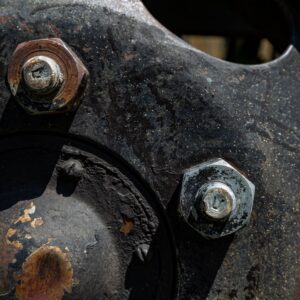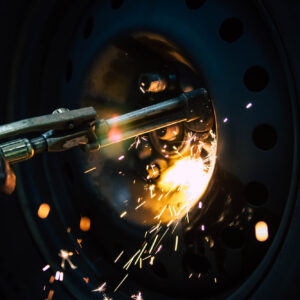There are few things more frustrating than dealing with cross-threaded bolts. Cross-threading occurs when a bolt becomes misaligned during installation, leading to the bolt not screwing into place as it should. This either means it won’t fully go into the hole it’s meant to enter or the corresponding nut it comes with won’t screw on properly. The resulting connection that the bolt is meant to hold is thus loose instead of sturdy and tight. Today, we’ll be going over some tips on how to fix a cross-threaded bolt and how to avoid cross-threading in general.
How To Fix a Cross-Threaded Bolt
There are various ways to fix a cross-threaded bolt. It’s best to try these methods if you’re adequately equipped and experienced. Some are more difficult than others so we’ve included some tips.
Lubricate
Before you do anything, try a little lubrication. You’d be surprised what some penetrating fluid or lubricant can do to coax a cross-threaded bolt out. Make sure the lubricant gets between the teeth of the bolt. Let it sit a while if needed to allow the lubricant to reach the cross-threaded section before trying to remove the cross-threaded bolt from its place.
Use a Rotary Tool
If lubrication doesn’t work, the easiest way to deal with a cross-threaded bolt is to go at it with a rotary tool and a blade attachment. Only do this if the bolt is cross-threaded on a nut, however. You don’t want to cut the cross-threaded section of the bolt off and leave it stuck in a piece of hardware.
Make sure you have enough room to operate the rotary tool without cutting anything else. This is especially important if you’re working on a cross-threaded bolt in a vehicle. There are a lot of important parts under the hood that will fail if you cut through them with a sharp, rotating metal disk. Either cut off the portion stuck to the cross-threaded nut and unscrew the bolt from its place, or cut the nut up into smaller pieces so it falls away from the bolt.
Disassemble as Needed
If a dremel is a no-go due to lack of space, you’ll need to start disassembling things until you can reach the cross-threaded bolt without endangering anything else. You’ll preferably end up with the offending bolt on your table in some form. Disassembly can be a complex project, so at this point you might need to call in a trusted mechanic or other professional to do the job.
Use Your Tools Creatively
Angling your screwdriver right might give you just the turning space you need to force the cross-threaded bolt to twist back out. Using pliers might manage to get a particularly clingy nut off a cross-threaded bolt. Sometimes it’s all about using your tools in clever ways.
Rethread or Replace
Replacing the cross-threaded bolt is always going to be the ideal solution, but sometimes, you just won’t be able to find an exact match. Since cross-threading damages the bolt’s threads, you might need to rethread the bolt before you can use it again. You can buy a simple rethreading kit from the store to rethread the damaged bolt.

What Causes Cross-Threading
Cross-threading is a familiar (and irritating) phenomenon for DIYers and mechanics alike. To understand it better, it’s important to know how screws, bolts, and nuts work. Screws and bolts have external winding threads that interlock with the internal threads of a nut or a hole. As the screw or bolt twists and tightens, the mated threads continue to follow each other.
Cross-threading occurs when these internal and external threads misalign. Angular cross-threading happens when the bolt or screw enters the threaded item at a misaligned angle. As the threads engage and the bolt or screw is tightened, the threads begin to shear, leading to damaged hardware. Parallel cross-threading, on the other hand, occurs when the tread patterns don’t match in the first place, or when power tools over torque the threads, causing them to misalign despite proper placement.
How To Avoid Cross Threading Bolts
While it’s good to know how to remove a cross-threaded bolt, it’s also a good idea to learn how to avoid cross threading your bolts in the first place. First off, if you want to be extra careful, screw in your nuts and bolts by hand before going in there with a power tool. This reduces the over-torquing risk and helps you align the threads correctly from the start. Cleaning your nuts and bolts before installing them in the first place is also a good idea. Dirt and grime in their threads can lead to cross-threading, so keeping them clean helps a lot.
Next, make sure the nuts and bolts you buy fit each other. Alternatively, make sure the bolt fits the hole it needs to fasten into. Poorly fitted fasteners are more likely to cross-thread because the threads won’t match up. Finally, be sure to apply perpendicular force when screwing in your bolt or nut. Push the bolt straight as you turn it to help you avoid angular cross-threading.
These might seem like a lot of extra steps to take just to reduce the chances of cross threading your bolts. But a majority of these preventive measures take under a few minutes to implement, and fixing a cross-threaded bolt can take hours. Trust us. All these little steps make a difference, and they’ll end up saving you time in the long run.
Get Replacement Bolts That Fit Your Car
Finding replacement bolts that fit in the same bolt holes as the cross-threaded fasteners can often prove difficult. If they aren’t compatible, the new bolts might end up loose or with cross-threading. Luckily, CarParts.com makes it easy to find the right bolts for your vehicle.
There’s a wide array of automotive parts to choose from here at CarParts.com. Our website’s integrated search engine makes it easy to find new bolts that suit your specific application and facilitate easy installation. All you have to do is enter your vehicle’s details to browse our product catalog. We exclusively source our products from trusted brands, so you know you’re getting bolts you can depend on. If you have any questions about our parts, our customer service team can assist you 24/7.
Look no further than CarParts.com when you need to replace old or damaged bolts in your vehicle. Order replacement bolts now and get your new parts in several business days.
Any information provided on this Website is for informational purposes only and is not intended to replace consultation with a professional mechanic. The accuracy and timeliness of the information may change from the time of publication.















